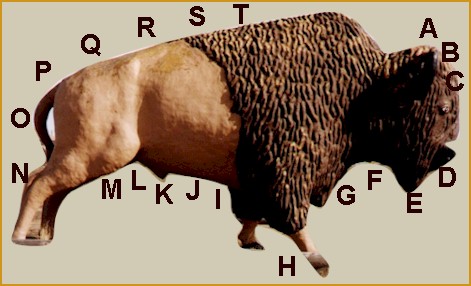The buffalo supplied virtually everything
that the Plain Indians needed to stay alive; food, clothing, tools,
and housing.

A. Brains - hide, preparation
B. Skull - ceremonies, sun dance,
prayer
C. Horns - cups, fire carrier, powderhorn,
spoons, ladles, headdresses, signals, toys
D. Tongue - best part of meat
E. Beard - ornamentation or apparel and
weapons
F. Rawhide - containers, clothing,
headdresses, food, medicine bags, shields, buckets, moccasin
soles, rattles, drums, drumsticks, splints, cinches, ropes,
thongs, saddles, stirrups, knife cases, bull boats, quirts,
armbands, lance cases, horse masks, horse forehead
ornaments, bullet pouches, belts
G. Buckskin - moccasin tops, cradles,
winter robes, bedding, breechclouts, shirts, leggings,
belts, dresses, pipe bags, pouches, paint bags, quivers,
tipi covers, gun cases, lance covers, coup flag covers,
dolls
H. Hoof & Feet - glue, rattles
I. Meat - (every part eaten)
pemmican (converted), hump ribs - immed., jerky (converted),
inner parts eaten on the spot
J. Four Chambered Stomach - first stomach
content: frostbite & skin diseases, liner: container for
carrying and storing water, cooking vessel
K. Scrotum - rattles
L. Bladder - sinew pouches, quill
pouches, small medicine bags
M. Paunch - lining for buckets, cups,
basins, dishes
N. Skin of hind leg - moccasins or
boots
O. Buffalo Chips - fuel, signals,
ceremonial smoking
P. Tail - medicine switch, fly brush,
lodge exterior decorations, whips
Q. Bones - knives, arrowheads (ribs) ,
shovels, splints, winter sleds, arrow straighteners, saddle
trees, war clubs, scrapers (ribs), quirts, awls, paint
brushes (hipbones), game dice
R. Muscles - sinew: bows, thread, arrows,
cinches, glue
S. Hair - headdresses, saddle pad filler,
pillows, ropes, ornaments, halters, medicine balls
T. Whole Animal - totem, clan symbol, white
buffalo sacred, adult yellow rare-prized
Source:
Akta Lakota Museum - Chamberlain, South Dakota

